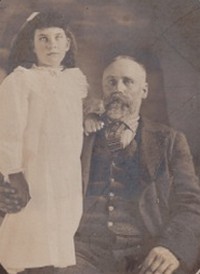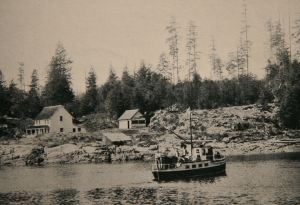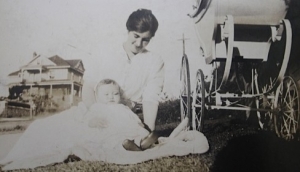Disturbing the Dead?
The Smith/Lang Family of Read Island & Port Neville, BC
Daisy Pearl McLennan told her family very little about her childhood, but she couldn’t resist a prideful boast that she’d been the first white child born on Read Island, BC, on February 12, 1893. She said her mother died in childbirth and shortly thereafter her heartbroken father sent her to an orphanage, where he sometimes visited. When she came of age she lived with her father for a time. And that was it. End of story.
But, with some research, Daisy’s birth date proved a match with that of a child born into different circumstances: a family who’d fallen upon troubled times, which I’d described in some detail in my book Tidal Passages. It was this book and Daisy’s birthdate that gave her grandchildren, Lois and Karen, a clue that Daisy might have invented some of the details of her childhood.
It was a fabrication she started from the time of her marriage, when she said her mother’s name was Hattie Smith. But what her granddaughter’s now understood was that her mother was Laura (Blakely) Smith. Laura had three children with John Smith before their move to Read Island, BC in 1888. It was a remote spot, but land was virtually free and they were joining friends who had a successful hotel and logging operation.
John Smith was not so lucky, or lacked the drive and smarts to make it work. His land was unsuitable for farming and his efforts at logging failed. To augment their income Laura turned to prostitution. One of her regulars was a logger named Henry Lang, who fathered Daisy.
Other men followed, bringing groceries in exchange for Laura’s favours. And John Smith seemed to accept Laura’s extramarital relations until something snapped and he clubbed one of her ‘Johns’ over the head with a shake cutting mallet. Chris Benson’s death, on the floor of the Smith’s bedroom, was slow.
Daisy, then just a toddler, was at home that day, but her half siblings were at school. When the others got home, they were puzzled by the groans coming from their parent’s closed bedroom door. Laura fed them a quick supper and hustled the kids out to play, while she and John dragged Benson’s now-lifeless body to his skiff. Smith’s plan was to set the man’s boat adrift, making it appear Benson had been at sea and had fallen and hit his head.
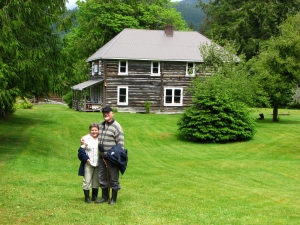
Myrna & Neil, on a Mothership Adventures cruise, outside the old Port Neville store, post office and Hansen family home.
But the local constable suspected foul play. He hired a man to ‘take up’ with Laura and sweet talk her into a confession. When she did, a trial ensued, but the all-male jury found Smith not guilty. The judge did not agree with their verdict. He said Smith should have been charged with manslaughter, not murder; and he blamed the jury for being swayed by favouring a man who they viewed as having been wronged by “a bad woman.”
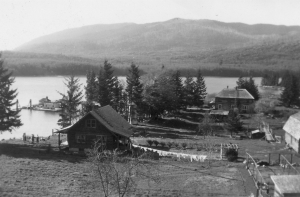
The Hansen homestead, with the main family home, post office and store on the right. Photo courtesy Museum at Campbell River.
After the infamy of this widely reported case, Laura left Read Island, taking Daisy with her. The other children remained with her husband; and two of the girls, who had testified against him, soon married.
Laura and Daisy headed to Havannah Channel, north of the Port Neville (their nearest port of call, store and post office.) They moved in with Daisy’s natural father Henry Lang, who lived in a little bay called Burial Cove. But Laura and Henry Lang did not remain a couple for long. When the census taker called in the spring of 1901, Laura and Daisy were living with another former Read Island logger to the southeast, in Topaz Harbour.
That relationship would also prove short-lived, but Daisy was free of her mother’s troubled life from 1901 on, when she was placed in a boarding school in Vancouver, perhaps paid for by her natural father, Henry Lang. And thereafter, Laura Smith moved further north to the remote community of Bella Bella, where she married for a final time and lived out her days.
We’ll never know if Daisy maintained contact with her mother, or her half siblings. We know from a Port Neville diarist, that her half brother visited for a time, before Daisy went to school. Her natural father, however, visited occasionally and when Daisy left school at eighteen she lived with him for a time.
She was proud of her father, who had the resources and wits to amass some savings at the time of his death in 1923 of $6,000 (enough to keep a family for five years or more.)
His relative wealth is perhaps what led Daisy to claim on her marriage certificate, in 1915, that her father’s profession was ‘gentleman.’ He left just $200 to her upon his death. The rest went to a young man who cared for him in his senior years.
As an old woman, alone with her memories, did Daisy retain at least a few fond memories of her early childhood–along with the painful ones of her troubled mother? Did she remember rowing among the islands of Havannah Channel, on route from Port Neville, music and community picnics at the Hansen’s farm? And was she ever able to gain compassion for her mother’s circumstances?
These questions intrigue her granddaughters, Lois and Karen. “I have wondered many times how our grandmother would feel,” Lois wrote in an e-mail, “if she knew we have discovered many of her secrets? My Dad says she would not be happy if she knew we were digging into her past. I feel a little like we have disturbed the dead. But, I am also very happy to give her a story, a childhood and a family.”
“I find myself thinking about [Laura] much more than I would have imagined,” she says. “Was she good to Grandma? Did she sing to her? Is this where Grandma learned her Irish ditties?”
Through Ancestry.ca Lois and Karen have made contact with relatives from Laura’s birth family. They can now trace Laura’s roots back to the 1600s, when her Irish family immigrated to the US.
Lois, who plans to write her family history, has many mysteries to probe. She won’t have to struggle, as some nonfiction writers do, to find intriguing characters and a plot rife with twists and turns.

